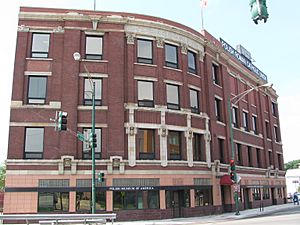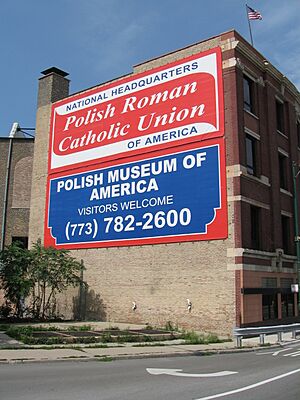Polish Museum of America facts for kids
 |
|
| Established | 1935 |
|---|---|
| Location | 984 N Milwaukee Ave, Chicago Chicago, Illinois 60622 United States |
The Polish Museum of America is a special place in Chicago, Illinois. It's located in an area that used to be a big Polish neighborhood. This museum is full of amazing Polish items. You can see artwork, old things, and beautiful embroidered folk costumes.
The museum started in 1935. This makes it one of the oldest museums in the United States that focuses on one ethnic group. It's also part of the Chicago Cultural Alliance, which is a group of many different cultural museums in Chicago.
Every year, the museum creates new exhibits. They also publish books about these exhibits in two languages. The museum hosts many public events. These events often happen with other museums and schools. The museum helps people learn about Polish history and culture. It shows off Polish and Polish American art. This includes paintings, sculptures, drawings, and prints by famous artists. Besides exhibits, the museum also has lectures, movies, and theater shows. They also host meetings with schools and people who love Polish Culture from all over the world.
The museum is also a key place for Casimir Pulaski Day. On this day, city and state leaders gather there. They honor Chicago's Polish Community.
Contents
- History of the Museum
- The Museum Building
- Cool Things to See: Permanent Exhibitions
- Entry Hall Art
- Stephen and Elizabeth Ann Kusmierczak Art Gallery
- Polish Folk Costumes and Crafts
- Tadeusz Kościuszko Collection
- Maritime Room
- Military Collection
- Helena Modjeska Exhibit
- Paderewski Room
- Panna Maria Exhibits
- Pope John Paul II Collection
- Casimir Pulaski Collection
- Other Interesting Exhibits
- Library and Archives
- Is the Museum Haunted?
- See also
- Related reading
History of the Museum
After a fire in 1931 destroyed a Polish library and museum, people in the Polish-American community wanted a new place. They wanted a museum in the United States. This new place would share Polish culture and history. It would also show how important Polish people were in North America.
So, the Polish Museum of America was created in 1935. It was first called the "Museum and Archives of the Polish Roman Catholic Union of America". Miecislaus Haiman was the first person in charge of its collections and library. The museum officially opened its doors on January 12, 1937.
The Museum Building
The Polish Museum of America is inside the main building of the Polish Roman Catholic Union of America. A famous Polish-American architect named John S. Flizikowski designed it. Building started in July 1912.
The building is made of special bricks and is in the Classical Revival style. Later, Art Deco decorations were added. These decorations are made of terracotta and are inspired by Polish folk art. The building is considered important for its architecture and history.
Cool Things to See: Permanent Exhibitions
The museum has many interesting permanent exhibits. Here are some of them:
Entry Hall Art
The stairs in the Entry Hall are covered with art. These works are by Polish and Polish American artists. They often show poster art about helping Poland during wars.
Stephen and Elizabeth Ann Kusmierczak Art Gallery
The art gallery on the third floor was closed for a few years. It was completely rebuilt and opened again on November 5, 2011. It's now called the Stephen and Elizabeth Ann Kusmierczak Art Gallery. Here, you can see many paintings and sculptures. They are by some of Poland's best and most famous artists. A lot of this art was shown at the New York World's Fair in 1939. After Poland was invaded in September 1939, the Polish Roman Catholic Union bought and saved the art. They brought it to Chicago.
Polish Folk Costumes and Crafts
The Folk Costumes exhibit shows Polish folk costumes from different parts of Poland. The Folk Crafts displays have a collection of old, traditional Polish folk crafts. This special collection includes pottery, metal items, and carved wooden objects from the 1800s and 1900s. The museum also has a great collection of pisanki (Polish Easter eggs).
Tadeusz Kościuszko Collection
The Tadeusz Kościuszko Collection has 73 handwritten letters. It also includes medals, drawings, and other items about Tadeusz Kościuszko. He was a Polish military leader who helped in the American Revolutionary War. The collection even has plans related to the Battle of Saratoga.
Maritime Room
The Maritime room has model ships and other items. It focuses on Poland's history between the two World Wars.
Military Collection
The Military collection shows uniforms, medals, and other materials. It highlights how Poles and Polish Americans took part in wars and conflicts. This includes battles both in America and other countries during the 1800s and 1900s.
Helena Modjeska Exhibit
The Helena Modjeska exhibit has theater costumes, posters, and items about the famous Polish-American Shakespearean actress Helena Modjeska. These items were given to the museum in 1947.
Paderewski Room
The Paderewski Room is a special part of the museum. It tells the story of the composer and Polish leader Ignacy Jan Paderewski. This room has the largest collection of Paderewski items in the world. You can see the pen he used to sign the Treaty of Versailles. There's also a Steinway piano made just for him. You can even see furniture from the hotel suite where he lived for the last two years of his life.
Panna Maria Exhibits
The Panna Maria exhibits have objects and items from the oldest Polish settlement in the United States. This settlement is in Panna Maria, Texas. It includes the original Stations of the Cross from the first church built by Poles in North America.
Pope John Paul II Collection
The Pope John Paul II collection shows items about Pope John Paul II. This exhibit focuses on things related to his visit to Chicago in 1979.
Casimir Pulaski Collection
The Casimir Pulaski collection has letters and items about General Casimir Pulaski. He was a Polish nobleman and military commander who fought for American independence.
Other Interesting Exhibits
The museum also has exhibits on Stained Glass, paintings by Kossak and de Rosen, a Model train collection, and a Polish Sailing Exhibit.
Some of the museum's most valuable items include a sleigh given by the Polish King Stanislaus Leszczynski to his daughter. There are also sculptures by the artist Stanislav Szukalski. You can see original drawings by Count Thaddeus von Zukotynski. The museum also has exhibits from the Polish display at the 1939 New York World's Fair. Another unique item is a bas relief carved in salt from the Wieliczka Salt Mine.
The museum also owns a famous painting called "Pulaski at Savannah" by Stanisław Kaczor Batowski. This painting won first place at the Century of Progress Fair in 1933. After the fair, it was shown at The Art Institute of Chicago. Eleanor Roosevelt herself unveiled it on July 10, 1934. The Polish Women's Alliance bought it for the museum in 1939. Another important painting is a very rare portrait of Edward Kozłowski. He was the first Polish priest to become a Bishop in America.
Library and Archives
The library and archives at The Polish Museum of America opened at the same time as the museum. They are there to help researchers, students, and anyone interested in Polish and Polish-American history. The archives have many paintings, documents, old coins, and items about the history of Poland and Polish people living outside Poland. They have a huge collection, from books about Polish Roman Catholic churches to records of volunteers for the Polish Army in France. The library's collections are very important for the museum's research, exhibits, and educational programs.
Is the Museum Haunted?
One of the most visited rooms is the Ignace Paderewski Room. This room started around June 1941 with gifts from Paderewski's sister. It also has items from the Buckingham Hotel in New York City, where Paderewski spent his last months. The room officially opened to the public on November 3, 1941.
Many people believe that the museum, especially the Paderewski Room, is haunted. Some think it might be Paderewski himself! The staff has many stories about strange things happening. The cleaning crew has even said they experienced ghostly events late at night. The Ghost Research Society was even invited by the museum staff to look into these claims.
According to the Ghost Research Society's website, there are some interesting stories:
- The museum's Operations Manager, Rich Kujawa, places flowers in the Paderewski Room on Paderewski's birthday (November 6) and the day he died (June 29). He noticed that the flowers from November 6 stay fresh and smell good for a long time. But the flowers from June 29 strangely have no scent and die quickly.
- Rich also remembers giving a tour to a school group. A cassette tape in the room suddenly started playing Paderewski's Minuet on its own. Then, just as strangely, it stopped playing after a short time.
- Two former museum volunteers said they would sometimes hear typing sounds while working in the Paderewski Room. Paderewski's typewriter is on display in that room. Rich thinks Paderewski was known for being a prankster when he was alive. So, maybe it's a playful ghost!
- A maintenance staff member, Helena Glinczak, has long felt a "presence" in the Paderewski Room. She has learned to live with it. A former weekend guide also felt uneasy entering the room.
- Other strange things include smelling burning and food cooking on the first floor, near the conference room. This happens when there is no clear reason for the smells.
See also
Related reading
- "Jamestown Colony: A Political, Social, and Cultural History (2007)"
- "Jamestown Pioneers from Poland, 1608-1958 (1958)"
- "Poles in the United States (1912)"


